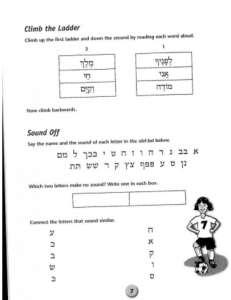A friend recently asked for my advice on the following: His friends, two successful professionals who speak English as a Second Language, wish to learn to decode in Hebrew for the purpose of following along in temple during the holidays. They aren’t really interested in learning to speak or understand Hebrew, I gathered; they just want to feel competent among their temple community by reading/chanting the prayers. A noble goal that many a Jewish institution has dedicated considerable resources to fulfilling!
Here’s where, for me and many other language educators, though, it starts to get very dicey. From a language educator’s point of view, deciphering and articulating lines and dots on the page is a precursor to reading; it does not constitute reading. Reading means comprehending written words. Pairing letters and their sounds is decoding – often the first step towards reading.
So the tens of thousands of us who attended a traditional supplementary Hebrew school (or cheder in my dad’s case), and who spent countless hours learning the letter/sound correspondences, and then tediously practiced repeating their sounds with vowel pointing (i.e., nikkud), didn’t really learn to read Hebrew in the full sense. We learned isolated phonemes and nonsense words, (and some real words, without knowing what they meant). This is how many modern-day Hebrew basal readers are still set up! (See sample below from Shalom Ivrit 1, Behrman House)
One problem with this decoding approach is that it’s tedious, boring, and worst of all, it’s devoid of meaning. Very discouraging for many students, especially youngsters, at 5:00pm on a Wednesday evening. For religious or Hebrew day-school students, it’s usually a short phase on the path to more satisfying, meaningful reading, as there’s the promise of comprehension during the considerable time spent on content-based literacy. For the rest of the temple-based Hebrew school students, with very limited Hebrew instructional time, not so much.
On the rare occasion that I go to shul with my siblings, as when they came to my son’s Bar Mitzvah this past May, I know that my experience during the service is wholly different than theirs – or from most of the attendees who can decode the prayers and readings in the prayer book. Those who retained their ability to decode but do not comprehend (like my sibs), may spend their mental energies merely tracking the text, perhaps occasionally checking the translation or commentary during liturgy transitions or English recitations. I, on the other hand, often understand the general meaning of the prayers as I read them, though biblical Hebrew is stilted. (Some compare it to Shakespearean English. I remember relying on footnotes, how about you?) All this to say, or rather to ask, how much time should we dedicate to decoding if it doesn’t get us meaning in the synagogue?
For my friend’s purposes, I responded like this:
As far as Second Language Acquisition theory goes, reading usually follows tons of comprehensible, contextualized and compelling aural input, so that the reader knows both what the words mean and how they’re supposed to sound, before sitting down to read a block of text. This is particularly important when the target language alphabet is so radically different, as in the case of Hebrew.
But that’s for acquiring the language; not for simply cracking the written code. It’s kind of unusual in world language teaching circles to have the goal be just the decoding and not mental mapping of the meaning, but hey, we’re Jews. We’ve been doing it this way (unwittingly?) for generations.
[There are prolly plenty of people who want to be able to read along in Hebrew, without worrying what the words actually mean (they have the English translation in the margin and commentary below!)….
Then there are tons who resent all the time spent decoding words they don’t comprehend. (You saw the Coen Brothers’ movie, A Serious Man?)]
I guess the best way for your friends to learn would be the way that so many of us and our parents did – by learning the sound/letter correspondence, together with the predictable melody that the prayers are wrapped in. But the order is important – learning it as a song FIRST will make the task, IMO, infinitely easier.
I would, then, after they know the short songs, use the simplest kid’s prayer book or Hebrew school workbook to look at the words in the most common blessings to start learning to decode. If they learn the first 6 words to most general prayers –
ברוך אתה __ אלוהינו מלך העולם
then they’d have several high-frequency prayerbook words under their belt, plus nearly half the letters in the Alef bet.
Before we start teaching discreet letter/sound correspondence, I’d see if they could do some “cold character reading” after they committed some of the short musical prayers to memory. Here’s a link to a brief video about Cold Character Reading, developed by Mandarin teacher Terry Waltz, PhD – again the technique rests on comprehension – which is very different from what your friends are looking for:
If they get a friend who’s willing to sit and teach them say, the 3 (short version) shabbat blessings (candles, wine, challah) to a melody (supports memory) – and they have a backup via a weblink with music – so they can commit it to automatic memory – then after several of those are slotted in, the letter/sound mapping will proceed more smoothly.
Here is one resource I just googled – it might be helpful:
There are more – you can find them at: prayer-eoke
Here’s a blogpost I wrote on Hebrew literacy, though again, it’s centers on attaching meaning. Still you may be interested!
I see I’ll need to get cracking on Part 2 soon!
Best,
Alisa
Do you understand the Hebrew prayers you read in synagogue? How did you (Or did you?) learn to decode, then read in Hebrew?
Any advice for this couple? Thanks in advance for posting a response and sharing your thoughts, experiences and advice!



